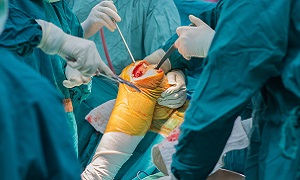Partial Knee Replacement
Partial knee replacement is a treatment for patients suffering from osteoarthritis. This surgery is an alternative to total knee replacement and can be done when the damage is confined to a particular compartment of the knee.
Although in the past, partial knee replacement was generally reserved for the older patients who were involved in fewer activities; now, partial knee replacement is often performed in the younger population as well. Around five percent of people who are suffering from arthritic knees are usually known to be eligible for this procedure.
Purpose
Usually, a knee joint is replaced for easing severe arthritis pain. Your doctor might recommend this procedure if:
- You are unable to sleep at night because of pain in your knees.
- Your knee pain is preventing you from performing your daily activities.
- Other treatments have not been effective in helping you with your knee pain.
Partial knee replacement is usually a good choice if you suffer from arthritis only in one side or part of the knee.
You might be a candidate if:
- You are older, thin and your lifestyle isn’t very active.
- The deformity in the knee is minor
- You do not have severe arthritis on the other side of your knee or under the kneecap
- You have a good range of motion in your knee
- The ligaments in your knee are stable.
This treatment is mostly recommended for people suffering from osteoarthritis, which is the wearing away of the connective tissue known as articular cartilage, within the joint.
Generally, knee replacement is done in older people, i.e. people over the age of 60. However, today even younger people undergo this procedure. Please note that if your condition is too severe, you might not be a good candidate for this procedure.
Preparation
It is important to let your health provider know about any medications, supplements or herbs that you might be taking. Also, ask him/her which medications you should continue to take till the day of the surgery.
It is likely that you will be asked to stop taking any medicine that makes it harder for your blood to clot. You may also need to stop taking any medication that weakens the immune system.
Your surgeon might ask you to stop smoking as well, as smoking affects your recovery. If you have been drinking a lot, you should inform your health provider. If you get the flu, fever, cold, etc. before the surgery, then let your health provider know.
You might also want to visit a physical therapist prior to your surgery so that you can learn exercise for a faster recovery. Practice using a cane, walker, crutches or a wheelchair on the day of your surgery.
On the day of the surgery, it is important that you don’t consume any food or drink at least 12 hours before the procedure.
During the procedure
Partial knee replacement is for removing any damaged tissue and bone in the knee joint and replacing it with an artificial implant, i.e. a prosthetic. The rest of the knee is preserved.
Before the surgery, you will be given anesthesia to block pain. It might general anesthesia or regional anesthesia. If general anesthesia is used, you will be unconscious during the entire procedure. If local anesthesia is used, you will feel numb in the area below your waist level.
Then your surgeon will make a cut below your knee level, which is about 3 to 5 inches long.
Then your surgeon will remove the damaged bones and tissues and replace them with prosthetics made of plastic and metal. Once it is equipped in the proper place, bone cement is used to attach it. After this, the wound is closed with stitches.
After the procedure
You should be able to go home the same day or you might require staying in the hospital for one day.
Once you return home, you should follow the instructions of your surgeon. This can include going to the bathroom or taking walks in the hallways with help.
You should also go for physical therapy as this can help improve range of motion as well as strengthen the muscles around your knee.
Results
Most people generally recover fast and have much less pain than they did before the surgery. People who undergo a partial knee replacement recover faster than people who undergo a total knee replacement.
Within three or four weeks after the procedure, many people are able to walk without a cane. Physical therapy is recommended for around three months.
Compared to total knee replacement, partial knee replacement preserves range of motion and knee function better. This is because it preserves the healthy tissues and bones in your knee. Due to this reason, patients are usually more satisfied with partial knee replacement as compared with a total knee replacement. If they ever need a total knee replacement in the future, they can still undergo it.
Risks
There are few risks associated with a partial knee replacement:
- An infection at the surgical site is a possibility. Sometimes there might be blood clots or injuries to a blood vessel or nerve, though such complications are rare.
- You might experience some knee joint stiffness.
- Sometimes, there might be late complications which can include infection and a loosening or dislocation of the prosthesis as well as continued pain.


